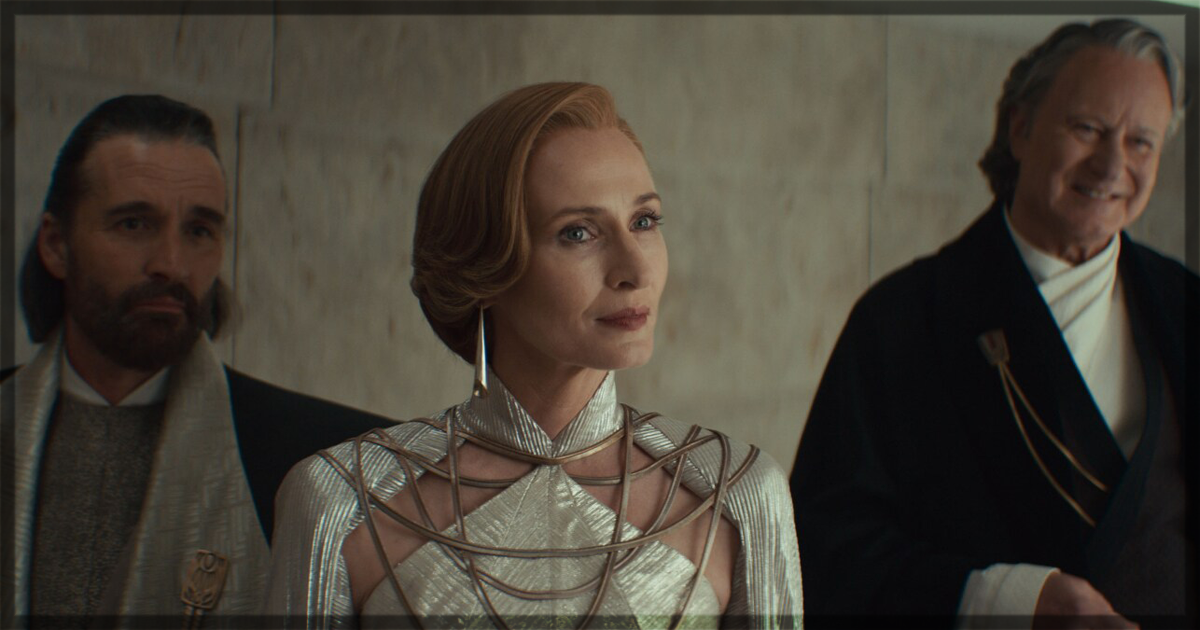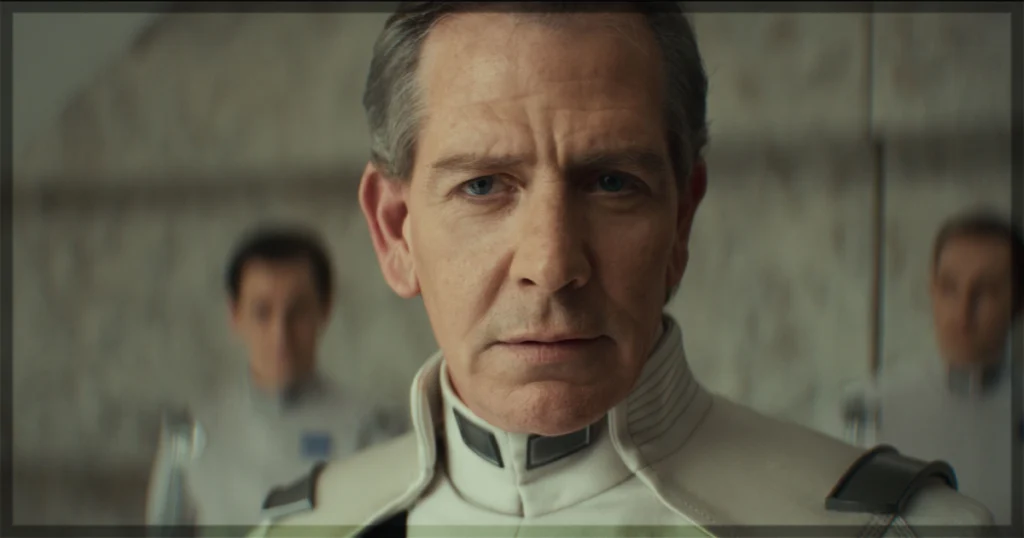In its second week, Andor’s second series has again jumped a year forward, covering a span of mere days in BBY 3. The jump can be disorientating at first, as the cast of characters finds itself in largely new configurations. However, the show is confident enough to hint at what has happened in the intervening time without relying on reams of expository dialogue, and the cast carries the weight of the Rebellion and their fraught histories with each other in their gestures and eyes. If anyone doubted that Andor was an excellently acted political thriller dressed up as a Star Wars adventure, the run of Ever Been to Ghorman?, I Have Friends Everywhere, and What a Festive Evening should put those thoughts to rest.
Among those forces of the Rebellion, Cassian (Diego Luna) and Bix (Adria Arjona) are on Coruscant in a safe house between intermittent missions, Wilmon (Muhannad Bhaier) is off supplying and training explosives with Saw Gerrera (Forest Whittaker, reprising his role from Rogue One and Andor Season 1), Mon Mothma (Genevieve O’Reilly) is back on Senate duty with her daughter married and attempting to keep the Emperor from even greater unchecked powers, and Vel Sartha (Faye Marsay) and Cinta Kaz (Varada Sethu) cross paths again in a climactic mission. But pulling the strings and calling the shots is Luthen (Stellan Skarsgard), who, along with Kleya (Elizabeth Dulau) has eyes and ears throughout the galaxy and clear ideas about what dominos need to fall when – and how dramatically – to get the Rebellion off the ground and topple the Empire. They, however, soon have a huge problem on their hands when Davo Sculdun’s (Richard Dillane) collection of antiques yields a fake, threatening to expose their own bugged products. Once again, this run of episodes keeps its key players largely separated. As What a Festive Evening closes, the audience knows more than any one single character (even Luthen!), but with Cassian a key player in the action instead of sidelined, the show’s purpose feels clearer.
Among the forces of the Empire, Syril (Kyle Soller) has accepted a new position as an inspector on Ghorman (to his mother Eedy’s chagrin, Kathryn Hunter still remaining the series MVP), and Dedra (Denise Gough) is working with Major Partagaz (Anton Lesser, given more to do and devouring each appearance) behind the scenes to see if Syril can infiltrate the heart of the Ghorman Rebellion. Orson Krennic (Ben Mendelsohn) and Doctor Gorst (Joshua James) also make appearances, the latter still haunting Bix’s PTSD-fuelled nightmares.
As this location focus and the fourth episode’s title may make clear, Ghorman – a wealthy, influential planet coded with berets, pouter pigeons, and last week’s aforementioned spider-driven textile industry – proves key to the action in BBY3. Orson Krennic’s speech about collapsing the planet’s industry and ecosystem has manifested in more Imperial presence on the planet and the construction of a new armoury, prompting protests from its residents as the large structure would cast a shadow on the monument to the Ghorman massacre. In Star Wars lore, Grand Moff Tarkin (Peter Cushing in Star Wars: A New Hope, and an ill-advised necromantic CGI creation in Rogue One – thankfully seeming not to appear in Andor) opened fire on a crowd of Ghormans blocking his landing on the square, killing five hundred civilians. Now, the nascent Ghorman Rebellion is passionate and driven, ready to get rid of the Empire at any costs, but they lack planning and expertise and are willing to welcome allies with open arms and not near enough suspicion. This is where Syril and Luthen both see opportunities: Syril sees an easy target for infiltration that would advance the Empire’s agenda and his and Dedra’s careers (their completely un-romantic romance still fascinates in brief snippets), and Luthen sees an opportunity for their first great victory – or the Rebellion martyrs that will drive other planets to rise up in revolution. As Luthen points out, such an affluent, tragic planet going out in a blaze of glory would burn bright as a signal and symbol of insurrection.
The middle episode, I Have Friends Everywhere, is perhaps the slowest-moving Andor has ever been, though this is not to the show’s detriment. In the intricate character relationships, Gilroy and episode writer Beau Willimon explore what the Rebellion, and revolution in general, mean for each of the characters. The world they dream of building, and the price they think is worth paying to bring it about, is thrown into sharp odds. Personal and communal ethics and stakes have never been higher, and fractures show in the Rebellion when people with the same cause but differing ideas, methods, strategies, and thresholds for acceptable loss get in the way of effective action.
There is an aphorism, or truth, or depressing joke that the left always divides and fragments, and it is easy to see why: with so much at stake, victory far from guaranteed, danger and death a certainty, and a new world free of authoritarianism a hopeful spectre but no clear picture, a single, universally agreed “best” course of action would be false and unrealistic – even in a space opera spin-off story. Cassian, for example, draws a line at Bix being asked to go on any mission without him in her current traumatised condition, and balks at Luthen’s accelerationist willingness to trade lives and planets to advance the cause; Luna’s performance when Cassian’s empathetic, caring side comes out is luminous, driving home the human lives put at risk.
To its credit, Andor does not definitively give viewers the right answer. Does Cassian give up too easily, losing sight of the forest for the trees? Does Luthen ask too much, making sacrifices that may never be worth it? Do Vel and Cinta overstep their marks demanding complete obedience when working with local inexperienced forces? The only thing that is certain is Saw Gerrera’s assertion to Wilmon that revolution is not sane, and not for the sane. But by contrast, Syril’s amazement that permission to foil Ghorman Rebel action is the best day of his life rings hollow and small. Who would want petty personal promotion when a more just, more fair, and more free world can be gained?
Once again, this block of Andor episodes ends with a party, a shocking death, and a stunning win delivered with style, all underscored by Brandon Roberts’ evocative music (this week’s themes in the horns felt especially Williams-esque). The twin tragedy and victory two hint towards the Rebellion’s best hope for success, and the extreme actions it will require. But many questions remain about how the pieces will come into place to facilitate the Battle of Yavin, and knowing how relationships grow or devolve in the next year is eagerly awaited.
Andor Season 2 is now streaming weekly on Disney+.
Learn more about the show, including how to watch, on the Disney site for the title.
You might also like…
‘Andor’ Season 2 Episodes 1-3 Review: One Year Later, Sagrona Teema, and Harvest


